#Hub Motor Electric Skateboards
Explore tagged Tumblr posts
Text
Electric Skateboard Market Witness High Growth Fueled by Rising Popularity of Eco-Friendly Transportation
An electric skateboard is a hand-controlled vehicle powered by an electric motor, batteries and wheels that provide greener alternative to conventional transportation. Electric skateboards are portable, provide longer range on a single charge and simplify rider's movement for commuting over short distances. Features like cruise control, smartphone connectivity and regenerative braking further make them user-friendly. Growing concerns regarding pollution and consumer inclination towards sustainable mobility options are fueling the demand for electric skateboards. Global electric skateboard market is estimated to be valued at US$ 4.07 Billion in 2024 and is expected to reach US$ 9.10 Billion by 2031, exhibiting a compound annual growth rate (CAGR) of 12.2% from 2024 to 2031.
Key Takeaways Key players operating in the electric skateboard market includes Boosted Boards, Marbel, Inboard, Yuneec, Mellow Boards and Stary Board. These companies are investing in developing long range, high torque electric skateboards integrated with advanced safety features. rapid urbanization and increasing traffic congestion across metros provide huge growth prospects for electric skateboards as an alternative commute method. Moreover, government initiatives promoting adoption of eco-friendly vehicles and investment in electric vehicle infrastructure would drive the market expansion. North America dominates the Electric Skateboard Market Demand attributed to high purchasing power of consumers and presence of major industry players. However, Asia Pacific region is expected to witness fastest growth due to rising middle class population, improving economic conditions and supportive government policies in countries like China and India. Market Drivers The key driver propelling the electric skateboard market growth is rising environmental concerns among consumers regarding pollution caused by fuel vehicles. Electric skateboards produce zero direct emissions and contribute to sustainable mobility. Also, cost advantages over fuel vehicles, ease of riding, portability and recreational benefits have increased product popularity, especially among youth. Government regulations regarding emission control and initiatives boosting EV adoption would further catalyze the electric skateboard demand globally over coming years.
PEST Analysis Political: The governmental regulations regarding the usage of electric vehicles on public roads impacts the electric skateboard market. Economic: The availability of attractive financing and lending options boosts the sales of expensive electric skateboards. Social: The growing popularity of adventure sports and inclination of people towards eco-friendly commuting solutions support the demand for electric skateboards. Technological: Advancements in lithium-ion battery technologies increases the driving range of Electric Skateboard Market Size and Trends. Development of smart electric skateboards with connectivity features through mobile applications gains traction. Geographical regions with concentration in terms of value North America dominates the electric skateboard market in terms of value, led by countries like the United States and Canada. Availability of high purchasing power, popularity of recreational activities, supportive infrastructure for electric vehicles, and presence of key market players drive the sales in the region. Fastest growing region The Asia Pacific region is expected to witness the fastest growth in the electric skateboard market during the forecast period. Rapid urbanization, increasing standards of living, growing youth population inclined towards adventure sports, and supportive government initiatives for electric mobility contribute to the high growth prospects. Countries like China and India showcase immense growth opportunities for electric skateboard manufacturers.
Get more insights on Electric Skateboard Market
Priya Pandey is a dynamic and passionate editor with over three years of expertise in content editing and proofreading. Holding a bachelor's degree in biotechnology, Priya has a knack for making the content engaging. Her diverse portfolio includes editing documents across different industries, including food and beverages, information and technology, healthcare, chemical and materials, etc. Priya's meticulous attention to detail and commitment to excellence make her an invaluable asset in the world of content creation and refinement.
(LinkedIn- https://www.linkedin.com/in/priya-pandey-8417a8173/)

#Coherent Market Insights#Electric Skateboard Market#Hub Motor Electric Skateboards#Belt Drive Electric Skateboards#Lithium Ion Batteries#Lead Acid Batteries
0 notes
Text
How Do I Choose the Right Electric Skateboard?
Electric skateboards have surged in popularity as a fun and efficient mode of transportation. Whether you’re a seasoned skater or a newbie, selecting the perfect electric skateboard can be a daunting task. Here’s a guide to help you navigate the options and make an informed decision on how to choose the right electric skateboard. 1. Determine Your Riding Style Your riding style is crucial in…

View On WordPress
#adventure#affordable#bamboo deck#battery range#belt-driven motors#budget-friendly#carbon fiber deck#casual cruising#commuting#control#deck material#Durability#Eco-Friendly#electric skateboards#electric transportation#entry-level#Evolve Bamboo GTR#features#High Performance#high speed#hub motors#Innovative Design#intuitive controls#Lightweight#long range#low maintenance#maple deck#Meepo V4#motor types#off-road
0 notes
Text
Do You Know the Principle of Skateboard Motors?
With the development of society, traffic pressure has become a headache virtually. Then various forms of electric sports tools appeared one after another. In recent years, electric skateboards have sold well in foreign markets. However, as a sports equipment, the electric skateboard generally requires the driver to have the feeling of surfing, so its design requirements and performance are quite different from those of the electric bicycle as a means of transportation.
Electric skateboards are required to have the characteristics of short starting time, fast speed, low noise, good climbing performance, and the system is often in a critical stalled state due to climbing and various actions of the driver. Increased difficulty.
Generally, drive electrolysis is divided into types such as DC motors, AC asynchronous motors, and switched reluctance motors. On current electric skateboards, DC motors are mainly used. Electric skateboards require low power, and the motor drive system is small in size and high in efficiency. At present, most of the motors selected in the market are DC motors. In terms of structure, DC motors are divided into DC brush motors and DC brushless motors. Because of its easy control and low cost, the brush motor still occupies a dominant position in the market, while the brushless motor is relatively complicated in electrode structure and control circuit, and the cost is relatively high. Currently, only a few high-end skateboard manufacturers use it, and the power range is 80W-400W. , the speed is 2000-4000r/min. The electric skateboard with 12V motor has a small power supply and the whole vehicle is light, but the current is large and the heat is released, which is not conducive to the heat dissipation of the whole vehicle, and the loss of the battery is also large, and the stroke is short. The weight of the electric skateboard with 36V motor is relatively heavy. The light and beautiful design poses a challenge but is beneficial to prolong the life of the battery and motor. Compared with the other two types, the electric skateboard with 24V motor has both advantages and weakens the two weaknesses. There are a large number of electric skateboards of this type on the market.
The electric skateboard with brushless DC hub motor and built-in intelligent control chip to ensure the stable output of power can shorten the response time of the skateboard, reduce noise and reduce the failure rate. Electric drive is the core component of skateboards, and its safety testing is very important. Therefore, consumers must look for conscientious manufacturers when choosing products. Quality is the life of products, and quality must pass the test.

2 notes
·
View notes
Text
Backfire Ranger X3 All Terrain Electric Skateboard
Backfire Ranger X3 is the newest all-terrain electric skateboard by Backfire, built with two powerful, water & dust resistant 1500W hub motors; 518Wh 12s3p 21700 ( updated to Samsung 40T cells since March 2023) high efficient battery system. Go away and have fun with Backfire Ranger X3. It is the Best All Terrain Electric Skateboard with Hub Motors in the market so far.




0 notes
Text

This aesthetically unique board allows for effortless riding with its 700w dual hub motor and 5 layers of maple board.
Enjoy a smooth ride with the latest electric skateboard luxury and reach your destination faster.
A new generation of power support for comfortable riding.
0 notes
Link
0 notes
Text
What are the various types of electric skateboard wheels for different riding styles?
If you want to feel the adventure and freedom of your ride, choose the best electric skateboard. But the one crucial component that significantly impacts your experience is the choice of the best electric skateboard wheels. The electric wheels for skateboards vary on the basis of your preferred riding style, whether you are cruising through the city, executing tricks, or tackling off-road terrain. Read the guide to learn the various types of electric skateboard wheels that can match your unique riding preferences.
Rubber wheel
Rubber wheels are the most flexible and common electric skateboard tyres. These wheels are softer compared to PU wheels, which makes them perfect for wet and slippery areas. They offer superior grip even on slippery surfaces while giving you a quitter ride.
Hub motor wheel
Hub motor wheels are a combination of electric motors which are best for offering effective and improved torque. These wheels are lightweight in nature and offer accelerated braking on steep inclines. But they are expensive compared to polyurethane wheels.
All-terrain wheels
If you travel through rough terrain most of the time, then all-terrain wheels are the best solution, as they provide excellent stability and shock absorption. You can use it on an electric longboard belt and a mountain board. It's best for unpaved, grassy streets and gravels. But they would be much slower on slippery roads.
Conclusion:
The ideal pair of wheels can completely transform your electric skating experience, improving both performance and enjoyment. Consider your riding style and the location terrain you frequent most when selecting electric skateboard wheels. Get in contact with Beastboard to find various ranges of skateboard wheel types.
To know more about High-quality Electric Longboard Belt. Please visit our website: beastboard.net
0 notes
Text
Electric Vehicles vs. Fuel Vehicles: How Do Their Design Fundamentals Differ?

In the ever-evolving landscape of the automotive industry, electric vehicles (EVs) have emerged as game-changers, challenging traditional fuel internal combustion engine vehicles on multiple fronts. One of the most intriguing aspects of this transformation is the distinctive approach to body design. In this article, we explore the stark differences between Electric Vehicles vs Fuel Vehicles and delve into how these distinctions influence the design fundamentals.
Mechanical Structure and Spatial Layout When we scrutinize Electric Vehicles vs Fuel Vehicles, one of the most prominent disparities is in their mechanical structure and spatial layout. Fuel vehicles necessitate a substantial front-end space to accommodate their bulky internal combustion engines, complete with clutches, transmissions, and exhaust systems. This engine-centric layout significantly dictates the overall shape of the vehicle.
On the contrary, Electric Vehicles harness smaller and more compact electric motors, eliminating the need for the vast engine compartment of their fuel counterparts. This freedom in design allows electric cars to exhibit shortened front overhangs and a sleeker, more streamlined appearance. Additionally, electric vehicles often do away with the complex mechanical transmission systems, directly transmitting power from the electric motor to the wheels through a simplified power transmission line. This streamlined approach not only affects spatial layout but also results in more interior space for passengers.
Integration of Components Integration is where electric car design truly shines in the Electric Vehicles vs Fuel Vehicles debate. The advancement of electronic control-by-wire technology has led to a shift in both electric and fuel vehicles, with traditional mechanical linkages being replaced by electronic systems. However, this shift offers electric vehicles a unique advantage, as it fosters a modular and seamless connection between the body and chassis. This integration allows for flatter chassis designs, offering designers more creative freedom in shaping distinctive body designs.
Moreover, electric wheel drive technology, gaining popularity in EVs, integrates the electric motor and planetary gear reduction device directly into the wheel hub, further simplifying the vehicle's structure and reducing the volume occupied by power and transmission components. This integration enhances overall vehicle efficiency and paves the way for innovative body design.
Aerodynamics Aerodynamics play a pivotal role in both Electric Vehicles and Fuel Vehicles, but the emphasis on efficiency and range in electric cars sets them apart. Electric vehicles prioritize reducing air resistance to extend driving range and improve energy efficiency. This translates to sleek contours and innovative aerodynamic features that minimize drag and enhance performance.
Battery Placement and Vehicle Weight Distribution Another crucial distinction between Electric Vehicles vs Fuel Vehicles lies in battery placement and vehicle weight distribution. Electric vehicles house a significant battery pack to store and supply energy, and designers must meticulously determine its placement for optimal weight distribution and balance. Placing the battery pack at the bottom of the vehicle, a design often referred to as the "skateboard" layout, lowers the center of gravity, improving stability and handling while offering a flat cabin floor for increased interior space. In contrast, fuel vehicles enjoy more flexibility in weight distribution, unburdened by the need to accommodate a large battery.
Sound and Noise Considerations Sound and noise management present a unique challenge in Electric Vehicles vs Fuel Vehicles body design. Electric vehicles operate quietly, thanks to the absence of engine noise. This silence, while advantageous for reducing noise pollution, necessitates the integration of artificial sound generation systems, known as "Acoustic Vehicle Alerting Systems" (AVAS), to alert pedestrians at low speeds. These sound systems must seamlessly blend into the vehicle's design to ensure effectiveness while preserving the aesthetic appeal.
In conclusion, the design of electric vehicles represents a paradigm shift in the automotive world, offering designers and engineers a canvas filled with innovative opportunities. The differences between Electric Vehicles vs Fuel Vehicles, encompassing mechanical structure, spatial layout, component integration, aerodynamics, battery placement, and sound considerations, underscore the unique factors that shape the exteriors of electric cars. These distinctions set the stage for a dynamic future of automotive design, where electric vehicles are at the forefront of innovation and sustainability.
To read more, click here.
Discover the latest models, specifications, features, and irresistible offers at SearchEV. Start exploring today!
0 notes
Link
#hustle#skateboarding#electric skateboards#electric vehicles#summer#viral trends#viral#green transportation#the futer#whatshot#buynow
1 note
·
View note
Text
Overview: Skateboard Hub Motors

Skateboard hub motors are an essential component of electric skateboards, providing efficient and powerful motion in a compact and lightweight design. In this article, we'll take a closer look at skateboard hub motors, exploring their design, performance, and applications beyond their features and applications.
Skateboard hub motors have a unique design that allows the motor to sit inside the wheel, providing a compact and space-efficient solution. The motor's stator is fixed to the inside of the wheel, while the rotor is connected to the axle. The design of the motor allows it to provide direct drive to the wheel, resulting in high efficiency and minimal power loss. The motor's compact design also means that it requires relatively low maintenance, as it doesn't have a belt or pulley system that needs adjustment.
Skateboard hub motor provides several performance benefits, including:
High torque: Hub motors provide high torque, making them suitable for climbing hills and accelerating quickly.
Regenerative braking: Some hub motors feature regenerative braking, which can help to extend the range of the skateboard by recharging the battery during braking.
Smooth ride: The direct drive of the motor to the wheel results in a smoother ride, with fewer vibrations and a more comfortable experience.
Quiet operation: Hub motors operate quietly, making for a more enjoyable ride.
Skateboard hub motors are suitable for a wide range of electric skateboards, including:
Commuter boards: Hub motors are commonly used in commuter electric skateboards, providing efficient motion for cruising and commuting.
Cruiser boards: Hub motors are also suitable for cruiser electric skateboards, as they provide a smooth ride and quiet operation.
Off-road boards: Hub motors are commonly used in off-road electric skateboards, providing excellent traction and stability.
Dual-motor setups: Some electric skateboards use dual hub motors for even greater power and performance.
Conclusion:
Skateboard hub motors are an essential component of electric skateboards, providing efficient motion in a compact and lightweight design. With their high torque, regenerative braking, smooth ride, and quiet operation, skateboard hub motors are an ideal choice for anyone looking to build or upgrade an electric skateboard. Whether you're commuting, cruising, or hitting the hills, a skateboard hub motor can provide the power and performance you need for an enjoyable and exciting ride.
1 note
·
View note
Text
Commuter Love
Pfou ! J’ai enfin pu boucler une quête ouverte depuis 10 ans maintenant, et je suis content. Vive la vie, vive le futur.
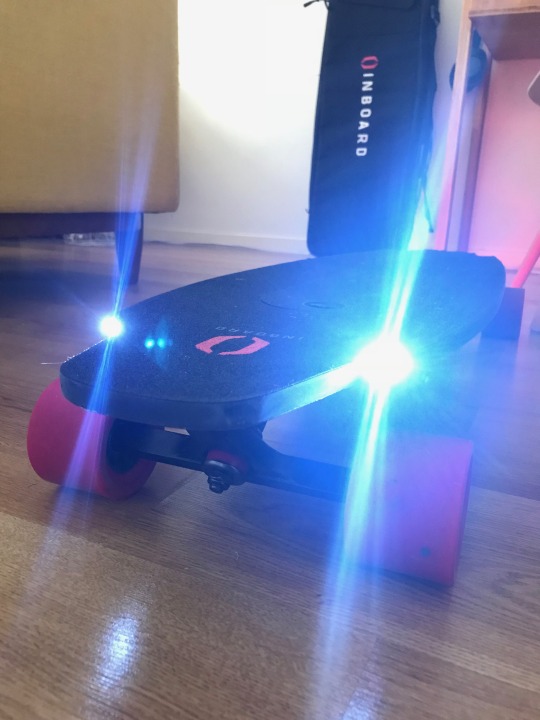
De quoi parle-je que vous-vous demandez à la lecture de cette intro pleine de mystère et riche de promesses. Attrapez-ma main et ensemble revenons aux origines du temps et de l’espace.
COMMUTE ORIGINS
Je bosse à La Défense depuis 2003 et une fois l’émerveillement de bosser dans un quartier d’affaires plein de gratte-ciels passé (au bout de 2 jours quoi), une vérité s’est imposée à moi : le trajet entre la gare RER de La Défense et ma COGIP située dans le quartier du Faubourg de l’Arche est chiant. A l’époque le CNIT et ce quartier récent étaient séparés par le boulevard circulaire et reliés par une passerelle quasi verticale aux marches tout droit sorties de la piste de Xapatan. C’était uuuuuultra relou :

Vers 2007-2008 la passerelle de la mort a giclé, remplacée par une dalle en pente douce sans aucune marche :

Dès que j’ai vu ça, je me suis dit “ça y est, un trajet d’une traite entre le RER et le bureau est enfin possible ! Joie !”
En 2011, j’ai acheté un vélo pliant de chez Strida. Il était hors de question que je fasse tout le trajet à vélo depuis chez moi donc il me fallait un truc pliable facile à transporter dans le RER. Le Strida 5.0 remplissait parfaitement ces conditions:

Je m’en servais quotidiennement pour faire le trajet domicile-gare et gare-bureau deux fois par jour. J’étais heureux jusqu’à ce sombre jour de septembre 2012 ou j’ai pu plier la fourche et la roue dans un sens non-prévu dans le manuel, à la faveur d’une rencontre riche d’enseignements avec un poteau malicieux du coté de l’Université De Vinci. L’incident a tué dans l’œuf mes ambitions de devenir un jour un cycliste professionnel sur vélo pliant :

Mais avant ce funeste évènement, j’avais déjà réalisé qu’avoir un vélo au quotidien c’était chiant : en plus de devoir se le trimballer partout (relou) ou de le laisser attaché dehors (suicide), il y a un aspect que j’avais sous-estimé lors de mon étude de marché : la maintenance. Pourtant j’avais pris un truc avec une courroie à la place de la chaîne et en single speed pour pas me faire chier avec les dérailleurs et tout le bordel. Mais ça n’a pas suffit, dès que j’ai mis le doigt dans la spirale de l’atelier, j’ai été happé tel le krill innocent qui passe devant la gueule ouverte de la baleine bleue débonnaire. Après plusieurs allers-retours physiques et numériques et un dernier message resté sans réponse après un énième souci à la mi-2013, j’ai remisé le Strida dans mon box et suis redevenu piéton. Ah ! Si l’unique distributeur parisien de ce formidable petit vélo n’était pas un sale con, peut-être qu’aujourd’hui je m’en servirais encore, “who knows?” comme on dit en enfer. Je suis donc redevenu un piéton et j’ai continué à envisager d’autres modes de transport pour aller plus vite. Roller ? Skateboard ? Snakeboard ? Les chaussures moches avec la roulette dans le talon ? La… Trottinette ?
En 2015, je tombe sur cette vidéo du Onewheel :
youtube
A l’époque c’est un projet Kickstarter qui se propose de mettre une roue de karting au milieu d’une planche, un peu comme un Solowheel (produit satanique) qui aurait préféré la posture de surfeur à celle du consultant senior en monoski. J’ai attendu patiemment la fin du Kickstarter, j’ai attendu le lancement de la prod, j’ai vu la v2 sortir (“Onewheel+”), j’ai vu la version avec une plus longue autonomie sortir (“Onewheel+ XR”), j’ai attendu l’annonce de la commercialisation en Europe et une fois celle-ci annoncée, je suis allé l’essayer dans un magasin spé à Chatelet. Le produit est super cool, silencieux, puissant mais gros défaut : il pèse lourd. A son contact, j’ai réalisé que cet appareil tient plus du véhicule de loisir de plein-air pour faire le fou le dimanche au Bois de Vincennes que du truc à prendre sous le bras tous les matins dans le RER. Ah et puis surtout, j’ai vu le prix de vente :

DEUX. MILLE. BALLES.
Du coup je jette un oeil au marché des e-skates en pleine explosion depuis que le vlogger Casey Neistat s’est affiché avec une Boosted Board en 2016. Je scout un peu le truc, beaucoup de marques clones chinoises (Yuneec, Meepo, Koowheel, Swagtron...), pas mal de trucs en DIY et une communauté de cinglés qui pensent que le futur de l’Homme c’est de slalomer dans le trafic à 45 km/h. Ces machins ont 4 roues et une planche mais sont à mes yeux aussi proches d’un skate que Laurent Wauquiez d’un homme d’honneur. Pas mon délire, moi je veux un truc sympa pour faire du commute, pas un rover martien tropicalisé pour aller péter des records de vitesse à Times Square.
Je remise le truc dans un coin de ma tête et passe à autre chose.
En avril 2018, je reprends la température du marché à la faveur de quelques potes qui s’interrogent et j’en arrive à une conclusion simple :

Pendant ce temps, le monde se fait envahir de trottinettes Xiaomi qui avec la M365 a réussi un coup de maître :
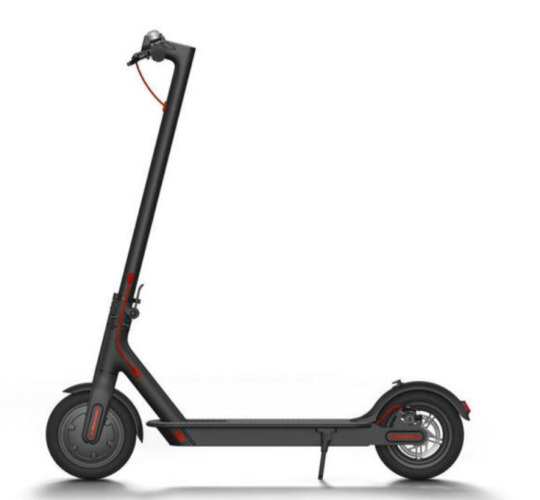
L’objet est très bien fini, performant et on le trouve autour de 300 EUR. L’espace d’un instant j’envisage l’achat avant de me raviser : aussi sympa soit-il, cet appareil reste une putain de trottinette. Et moi les trottinettes, je peux pas. Dans mon système de valeur, la trottinette est au transport ce que les Duplo sont au jeu de construction. Tu peux construire la cathédrale de Chartres avec, ça restera une cathédrale en Duplo. Ouais c’est idiot mais j’ai jamais dit que je ne l’étais pas.
Je vois plein de gars à la Défense slalomer à la cool entre les piétons, la cravate flottant au vent, je les envie un peu ces bâtards, puis je me rassure en me disant qu’ils sont sur une trottinette, même si elle est puissante et racée.
Je reprends donc contact avec tout ce bordel et je scrute de plus près la Inboard M1, une planche kickstartée que j’avais croisé en 2016 et à propos de laquelle j’étais relativement sceptique :

Je checke Reddit, depuis 2016, la board a été livrée. Les reviews que je croise se plaignent des fausses promesses d’Inboard concernant le poids de la planche sous-évalué et l’autonomie surestimée. Classic Kickstarter shit, mais au moins Inboard a livré un produit. Quelques soucis techniques également ici ou là, un problème d’étanchéité et des soucis moteurs mais dans la grande majorité des cas il s’agit des modèles envoyés aux backers.
Message de service : quand vous backez un truc sur Kickstarter, n’oubliez jamais que ce que vous allez avoir, c’est un modèle de pré-série. Pour le M1 les backers ont été les beta-testeurs et leurs retours ont permis d’affiner le produit final avant de lancer la vraie production.
Résultat : la planche n’a pas bonne presse auprès du subreddit r/electricskateboarding qui compte surtout des gens qui voient dans leur planche leur mode de déplacement urbain principal. Mais aussi critiques soient-ils, tous s’accordent à dire que la planche est très bien finie, que pour un premier produit Inboard s’en sort bien et que pour du commute ça fait carrément le taf. Faut juste savoir à quoi s’attendre concernant le mode de propulsion. Et ça tombe bien parce que c’est aussi ça qui m’intéresse, moi, le mode de propulsion.
LE BONHEUR EST DANS LA ROUE
Dazplaining :
La grande majorité des skates électriques, dont ceux de chez Boosted, utilisent des courroies. On dit de ces planches qu’elles sont “belt-driven” : les moteurs font tourner deux courroies qui entraînent les roues arrières :

L’alternative choisie par Inboard et quelques autres marques (dont Acton il me semble) est celle du “hub motor” : les moteurs sont DANS les roues (comme un Onewheel tiens tiens) et entraînent directement la planche. Dans le cas du M1, on peut même dire que les moteurs SONT les roues, en fait :

Ceci a trois conséquences qui sont celles qui m’ont vendu le produit.
Primo : la planche reste clean, de prime abord on ne voit même pas qu’elle est électrique puisqu’aucun élément ne traine sous la planche et ça j’aime bien.
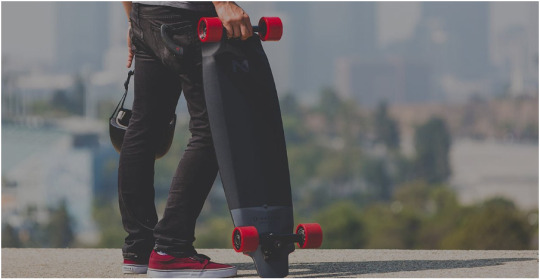
Deuzio : Aucun élément n’étant exposé, la planche est certifiée Water Resistant IP54 et peut être utilisée sous la pluie (le problème d’étanchéité évoqué plus haut concernait la trappe de la batterie et a été corrigé sur les modèles de production). Après on est bien d’accord, utiliser ce machin sous la pluie, c’est du suicide. L’utiliser juste après, par contre, et rouler dans les flaques sans craindre de flinguer l’appareil, c’est appréciable.
Triano : les hub motors tournent librement quand ils ne sont pas sollicités contrairement aux belt motors dont les courroies freinent les roues. Une planche comme la M1 peut donc être poussée à l’ancienne si la batterie est à plat. Et vue son autonomie, c’est quelque chose qui risque d’arriver.
Ceci se fait a priori au détriment du couple et de la vitesse de pointe qui ne peut égaler celles des planches à courroies. C’est un défaut qui est pour moi compensé par une caractéristique qui est devenue ma priorité sur un skate électrique : pouvoir coaster librement, méthode célébrée par Lupe Fiasco dans son “Kick, Push” :
youtube
La glisse en roue libre, le coast donc, c’est pour moi l’essence du skate (perso, rien à foutre des tricks) : on se propulse et une fois arrivé à la vitesse souhaitée on glisse tranquille. Puis on remet un peu de gaz et ainsi de suite. Je ne sais pas si les courroies permettent de coaster aussi librement mais vu qu’elles n’ont pas de roue-libre, j’imagine que ça ne doit pas être aussi fluide qu’un skate classique. Si vous avez testé et que vous pouvez m’éclairer sur ce point, je suis preneur.
LE FUTUR C’EST MAINTENANT
J’ai donc sauté le pas et ai acheté le Inboard M1 sur Amazon. Une somme assez indécente et 3 jours plus tard, je reçois la bayte.
Constat immédiat : c’est beau. La planche est sobre, toute de noir vêtue, et le dessous est vraiment superbe. C’est lourd (6 Kg) et ça dégage un sentiment de robustesse fort bienvenu. Le process d’appairage de la planche avec la télécommande et/ou l’app mobile est assez génial : on allume la telco, on retourne la planche et on toque 3 fois dessus. Les feux se mettent à clignoter doucement, signe que la planche cherche la télécommande à portée et deviennent fixes quand elle l’a trouvée. C’est d’une simplicité totale, pas de boutons, pas de process de pairing bluetooth, pas de code de jumelage, rien. Ca m’a fait penser à du Apple et c’est pas mal comme comparaison pour un premier produit.
La planche arrive rangée dans son sac de transport, CAR SAVIEZ-VOUS QUE VOUS POUVEZ PRENDRE L’AVION AVEC ?

Inboard insiste en effet pas mal (euphémisme) sur le fait que sa batterie est TSA compliant et peut être prise dans un bagage cabine en avion tandis que la planche voyage en soute. Les skates electriques sont généralement interdits de vol à cause de leurs batteries au Lithium non-amovibles donc Inboard le rappelle dès que c’est possible. Ok, cool. C’est cette batterie amovible qu’Inboard utilise aussi pour balayer les critiques concernant l’autonomie tout juste correcte de sa planche :
“Vous voulez plus d’autonomie ? Bah achetez plus de batteries.”
A 200 dolz la batterie supplémentaire, c’est moins cool même si ça reste vrai dans l’absolu.
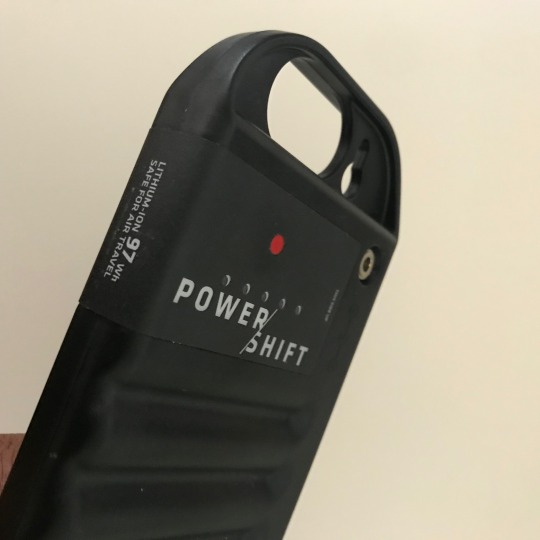
Le M1 se contrôle à l’aide d’une télécommande nommée RFLX Remote (marre des noms sans voyelles, mais ok) livrée dans une petite boite de transport, “utile quand vous transporterez le M1 dans son sac car SAVIEZ-VOUS QUE VOUS POUVEZ PRENDRE L’AVION AVEC VOTRE M1 CAR SA BATTERIE EST AMOV-”
Ouais ça va, on sait , merci :
Le maniement est simplissime, la telco comporte une gâchette qui joue le rôle de bouton de l’homme mort, un stick analogique et un bouton On/Off.
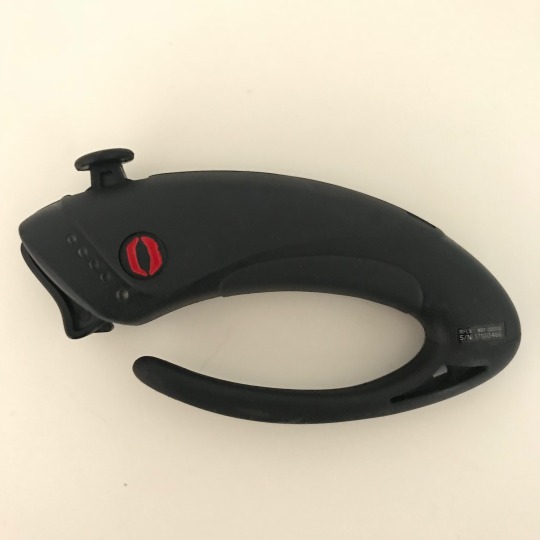
Pour avancer on maintient la gachette pressée puis on utilise le stick. Pour freiner, on met le stick dans la position inverse et voila.
Les 5 diodes présentes servent à consulter le niveau de batterie de la telco et du M1 (double-appui) et servent à alterner les 3 riding modes (beginner, intermediate, advanced) via un triple appui. Il y a aussi des raccourcis, comme par exemple gachette + bouton On qui permet d’éteindre les feux de position de la planche.
ET A L’USAGE ALORS ?
Je vais être franc : C’EST SUPER DANGEREUX. En posant le pied sur ce machin, on comprend pourquoi le risque de mort est indiqué à la 3e page du manuel utilisateur :
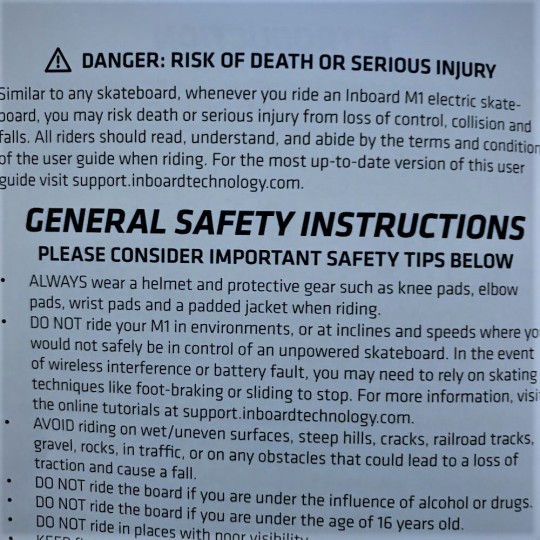
Les vitesses sont plafonnés par mode. Le Beginner est limité à 8 km/h, le Intermediate à 22 km/h et le Advanced à 32 km/h. A l’heure où j’écris ces lignes, j’ai parcouru 20 km avec cette planche et je n’ai pas encore osé taper la vitesse Max. Les redditors et leurs délires de planches qui filent à 45 km/h sont cinglés, PERSONNE ne devrait rouler à plus de 25 km/h sur la voie publique, avec des vélos, des piétons et des voitures à proximité. Les grandes roues de la board permettent de passer pas mal d’obstacles mais des trucs triviaux comme les changements de revêtement de la chaussée (oh que j’aime l’alternance goudron/segments pavés de Maisons-Alf <3), anodins à vélo, prennent une autre dimension quand on est lancé à 30 km/h sur un truc aux roues en uréthane et sans aucune suspension. Et je ne parle pas du mobilier urbain, inoffensif à pied qui prend une allure bien plus menaçante quand on le croise debout sur un bout de bois.
Les modes sont mal étagés, le beginner est en fait un mode démo pour quand vous voulez faire tester la planche à quelqu’un. Pour le proprio il n’a plus aucune utilité au bout de 3 minutes, et encore. En plus de ça l’accélération et donc le couple disponible sont aussi lockés par mode. Avec mon gabarit que l’on peut qualifier de généreux selon tous les standards ISO en vigueur, je dois parfois utiliser le mode 3 pour avoir plus de couple dans certaines situations comme des pentes un peu prononcées ou un démarrage à une intersection que je veux vite franchir puis vite basculer sur le 2 pour éviter de m’emplafonner dans un bus 30 m plus loin parce que j’aurais atteint la vitesse du son entre-temps. Je n’ai jamais autant ressenti la fragilité de l’existence qu’en cruisant dans ma ville mais…
LES SENSATIONS SONT OUFFISSIMES !!!
Rouler de nuit sur une piste cyclable bien clean avec le vent dans les cheveux et le bruit des roues sur l’asphalte souligné par le bruit futuriste du moteur quand on remet un peu de jus, c’est un pur bonheur. Je n’ai pas un background fourni en e-skate mais si des gens trouvent le M1 décevant, je n’imagine pas ce que doivent donner leurs boards de prédilection.
Un des points positifs qui remonte le plus souvent sur Reddit, c’est le comportement de la planche. Elle ne donne pas l’impression de devoir dompter un mustang épileptique à chaque sortie contrairement à d’autres marques (apparemment Evolve est un nom qui revient souvent dès qu’on parle de sauvagerie totale). Pour l’instant le M1 ne m’a pas mis en défaut, les quelques frayeurs que j’ai pu me faire sont entièrement de ma faute.
Coté évolutivité la mise à jour des firmwares de la planche et de la télécommande se fait via l’app iOS Inboard Vision. Plutôt claire et bien foutue quoiqu’assez sommaire, elle permet aussi de contrôler la planche en l’absence de la télécommande (je déconseille fortement) :
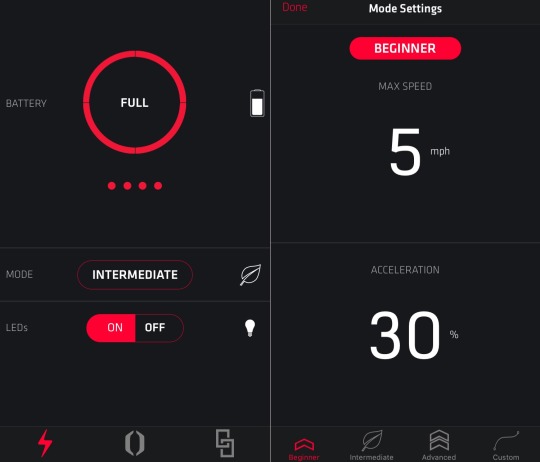
J’ai mis à jour le firmware de la planche (je ne pensais pas écrire ce genre de truc un jour), elle passe en 2.4 et ajoute maintenant un mode veille prolongée pour éviter de vider la batterie quand on n’utilise pas la planche (elle cesse de chercher la télécommande au bout de 60 secondes et ne recommence que si le gyroscope interne détecte un mouvement). L’autre ajout c’est un allumage plus fort des LEDs arrière lorsque l’on freine. Des feux de stop quoi. Ils sont forts quand même chez Inboard.
Vous l’avez compris, le produit me plait, ce n’est pas la meilleure board pour en faire son moyen de transport urbain principal mais en même temps, je ne suis pas new-yorkais, donc j’osef. Pour faire le lien entre 2 modes de transport et se balader à la cool, le M1 semble tout indiqué. Le suivi d’Inboard est plutôt encourageant et je leur souhaite de sortir plein de produits dans la même veine.
Maintenant on ne va pas se mentir, je reste sur la défensive quant à la durée de vie du produit. Les trucks, les roues, les roulements sont standard, pas de souci pour s’approvisionner ailleurs, par contre les roues arrière/moteur et la couche d’uréthane sur mesure qui sert de roue (“REV wheels”) sont propriétaires, tout comme Fouiny, la batterie et la télécommande. Si Inboard met la clé sous la porte, je vais me retrouver niqué en cas de casse. Et malgré l’aspect maintenance-free mis en avant par la marque je ne me fais aucune illusion : 120 Kg posés sur une planche mue par 2 moteurs de 800W chacun qui roule tous les jours sur des pavés, c’est ÉVIDENT que ça va péter à un moment donné.
Malgré ce nuage à l’horizon, je peux dire ici que le M1 est l’iPhone des skates électriques et ce n’est pas péjoratif: ce n’est pas le meilleur coté performances, mais c’est celui au design le plus sympa, aux petits détails soignés et qui reste le plus homogène en termes de qualité perçue et d’expérience de glisse. Pour 999 USD, il vaut son prix. A 1300 EUR, je comprends qu’il faille réfléchir un peu avant d’arrêter son choix. Je me doute que d’ici 1 an il existera un concurrent sérieux sur tout ce qu’Inboard a fait correctement pour les 2/3 du prix. Mais une fois qu’on est en phase avec la vibe du M1 en termes d’accélération et de vmax, le seul vrai point noir c’est l’autonomie un peu juste, dictée par la certification TSA qu’Inboard a voulu obtenir et qui interdit de passer la barre des 97Wh pour une batterie.
Une boite sympa proposerait à la vente des batteries plus puissantes mais affichées comme non embarquables en avion. Une boite moins sympa ne proposerait rien et regarderait ses clients acheter 2 batteries standard au lieu d’une seule XL pour maximiser ses ventes.
Satané capitalisme.
#inboard#m1#eskate#skateboarding#Electric#esk8#Hub Motor#Boosted#Meepo#Acton#review#LEV#PEV#Vehicle#Portable#France
2 notes
·
View notes
Text
Most Powerful Hub Motor for Building DIY Electric Skateboards
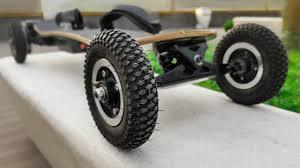
building a stealthy high-performance high-torque electric skateboard has never been this easy. My name is JasonPotter I'm the founder of Enertion boards and also the founder of one of the biggest electric skateboard forums in the world.
My company Exertion is most famous for bringing out innovative high-performance electric skateboard components for DIY builders people who want to make their own awesome Electric skateboards at home ok I'm sure you all want to see what's in the box so let's do a quick unboxing I'll go through all the little bits and pieces that you get in this kit and then I'll do a little bit more in-depth explaining once I've got it all out let's have a look! Ok the first thing you see when you open the box is a for box Unity! this is an awesome product andI'll go into more details about why it makes building Electric skateboards so easy in just a minute oh now we've got this it's heavy you can pump some weights with this guy it's two Massive hub motors here you probably can't tell by looking at it but there are motors inside these wheels there's also integrated liquid cooling technology so that you can really get maximum performance and keep the motors running cool.
we've also got the front truck assembled with wheels and bearings everything ready to go. you get some truck risers, one for the front and back truck bolts. you also, get some circuitry there to help you connect the motors and the unity together without a headache ok so I'll go through each part with a little bit more detail just so you know exactly what all this does. so firstly we've got the Focbox unity.
This is an amazing product and you can buy it or you can get it added into this kit for only $199 USD so it's really good value getting it all as a bundle and it's available on our website to order now let's have a look what you actually get in this box and what is it? it's a dual motor control this thing is amazing it actually comes with an awesome app for Android and soon to be iOS that allows you to program everything from your phone set it up you can even do things like set the speed limit so if you've got young kids and you don't want them hurting themselves going too fast you can program things like that into it or you can fully tweak the performance if you're into racing and you want to leave everyone in the dust.
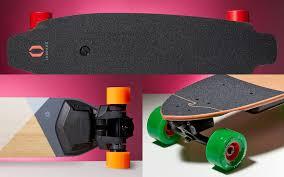
so the for box unity it's so simple to set up.All you've got here is these connectors that go directly into the motor and we've also got a special adapter here which makes it super easy plug it all in run the app it's got an automatic wizard in there that sets it all up for you-you're pretty much ready to go in a matter of minutes we've got standard skateboard components here like I mentioned the risers we've got eight deck bolts and the trucks.
get yourself a deck, get yourself a battery, mount it all on to the deck and you're really ready to go with a high-performance build in a matter of minutes.
so if you want to get some really great ideas on how to build an awesome electric skateboard, head over to our electric skateboard builders from the links in the description you can see what people are doing, people have already got these - we've already shipped these out to people they're in stock they're ready to go, people are going to be building amazing builds with this stuff we can't wait we've also got pro riders lined up who are going to be making four-wheel drive skateboards with these so don't worry about that, four of these motors! it's gonna be crazy, they're gonna be racing this summer races are coming all over the world for electric skateboard enthusiasts now so look them up to check them out see what everyone's doing, it's real game-changer it's never been this easy to make an electric skateboard before.
We've put in hours of engineering research and development we use this stuff on our own Raptor 2, so we've ironed out all the problems we've tweaked it the best we can make it so easy for anyone to build now it's available for you to order check out our website now place your order and we'll get it shipped out worldwide in a matter of days.
#Most Powerful Hub Motor for Building DIY Electric Skateboards#electric skateboard#best electric skateboard
0 notes
Text
Shop Now: Backfire Ranger X5 All Terrain Electric Longboard
BACKFIRE RANGER X5 The Backfire Ranger X5 is the epitome of all terrain hub motor design from over 10 years of experience crafting Electric Skateboards. Light Up Abs Strip Encompassed Within The Abs, We Have Installed Luminous Leds, So The Abs Protected Leds Will Not Get Damaged Or Broken During The Normal Use Conditions. The Technology Took Over 1 Year R&D By Backfire. Modern Remote Halo remote is one of the best remotes in the market for Electric Skateboards. You can adjust the braking and acceleration, directly from the remote, the display also shows charging state. Fingerprint recognition is also included. Ultra-High Voltage System The Full Charge Voltage Is 50.4v. High Voltage Has Many Advantages. To Put It Simply, The Higher The Voltage, The Higher The Efficiency, The Longer The Range Powerful Battery The Ranger X5 Features A 518wh Battery Granting Amazing Range For Its Size! 10″ Double Kingpin Trucks Learn More About The Halo Remote Personalized Performance Adjust the performance of the Ranger X5 to suit you or your loved one. The acceleration, brake strength, and top speed are all customizable. Specs: Deck: Composite deck 4010inch with Red Light Trucks: 10-inch Double Kingpin Trucks Wheels: 165mm45mm 70A Battery: 12s3p Samsung 40t, 518wh ESC: BACKFIRE 12S 90A FOC Motors: 1500W*2 Dual Hub motors Remote: 2.4GHz 1.5inch color Oled Halo Remote Weight: 12.8Kg/28.22lbs Max Load: 120kg/265lbs Top speed: 26mph/42kph Range: 18-21 miles/28-35km (180lbs rider 18.5mph flat road) Hill Climbing: 30% Water resistant: IP65 Charging time: 3.5 hours Whats in the Box: Ranger X5 Electric Skateboard Backfire Halo Remote Charger T-Tool Error Detection Cable Type-C Charging Cable Spare Screws Set of Hex wrenches Manual and sticker pack




0 notes
Text

Experience the freedom of the electric skateboard cruiser! Designed by Skateboard Australia, this versatile board is your ticket to exploring the streets and embracing the skateboarding culture.
From cruising along the beach to navigating urban landscapes, it's time to unleash your inner skater and ride with style!
0 notes
Text
Best Hoverboard Brands
In today's busy life, people do not have enough time for their leisure time activities. We should do the things that give us peace of mind. Today many people like to spend their free time with electrical appliances. We will talk about one of them. We'll talk about hoverboards. Hoverboards are a great way to spend your free time. Hoverboards are available in the market with many brands. Let's take a look at those famous hoverboard brands.
1. Epikgo Self Balancing Scooter
With a range of 10 miles from starting, Epikgo Self Balancing Scooter is one the best electric hoverboards. The running capacity is double as a one hour as compared to other hoverboards. It can be your commute vehicle. It takes only two hours for charging. With the size of 8.5-inch tires, Epikgo hoverboards are capable of wet and dry both conditions. The most important thing is that, the Epikgo Hoverboards are water-resistant.
2. Tomoloo Hoverboard with LED Lights
One of the top pick by kids as well as adult Tomoloo Hoverboard with LED Lights is fast and easy to learn and operate. The LED lights built–in Bluetooth speakers in Tomoloo Hoverboards. With a 4-hour long-life battery and it only takes 1 hour to charge, which is one of the shortest charging times on our list. You can operate Tomoloo Hoverboards in both wet and dry places with a top speed of 7.5 MPH. The top feature of this hoverboard is that, you can play music directly from your mobile phone with a Bluetooth system and it is connected with LED flashing lights which make your ride more wonderful.
3. Jetson Aero All Terrain Hoverboard
Hoverboard lover who likes a ride on grass and gravel, here is one of the suitable model for this surface is Jetson Aero All Terrain Hoverboard. If you’re planning to leave the flat surface, you should definitely go for Jetson hoverboards. This hoverboard has a 300-watt dual hub motor which helps to ride on any surface. Riding in low light is a bigger problem so the colorful LED lights of Jetson Aero Hoverboards illuminate your path. On one charge, you can ride up to 7 miles easily as well as it can accommodate loads up to 195 pounds.
4. XPRIT Hoverboard
One of the affordable hoverboard on our list is XPRIT Hoverboard. It is a perfect hoverboard for kids considering features like Bluetooth wireless speakers and LED lights. XPRIT hoverboard comes in multiple colors. It is easy to operate and carrying because of lightweight, that’s by this hoverboard is the most favorite and best pick by kids as well adults. Colorful LED lights are of the premium feature which makes the ride more bright and smooth. The colors change according to music. XPRIT hoverboards don’t sacrifice too many premium features in order to save some money.
5. Viro Rides Free-Style Hoverboard
The Viro Rides Free-Style Hoverboard is an evolution of design that featuring two side-by-side central wheels instead of one. Riding Free-Style hoverboards is just like riding a skateboard. But it is really more like snowboarding. The ride of Viro Rides Hoverboards is very safe as compared to others. It also displays a handy dashboard with your current speed and battery level. The rider can ride viro up to 6.5 miles on a single charge with a maximum speed of 7 mph. Viro Rides Free-Style Hoverboard can accommodate riders up to 220 pounds.
Visit Our Official Website - Hoverboard
1 note
·
View note
Text

Beast dual drive hub motor
Holiday hot sales
https://beastboard.net
2 notes
·
View notes